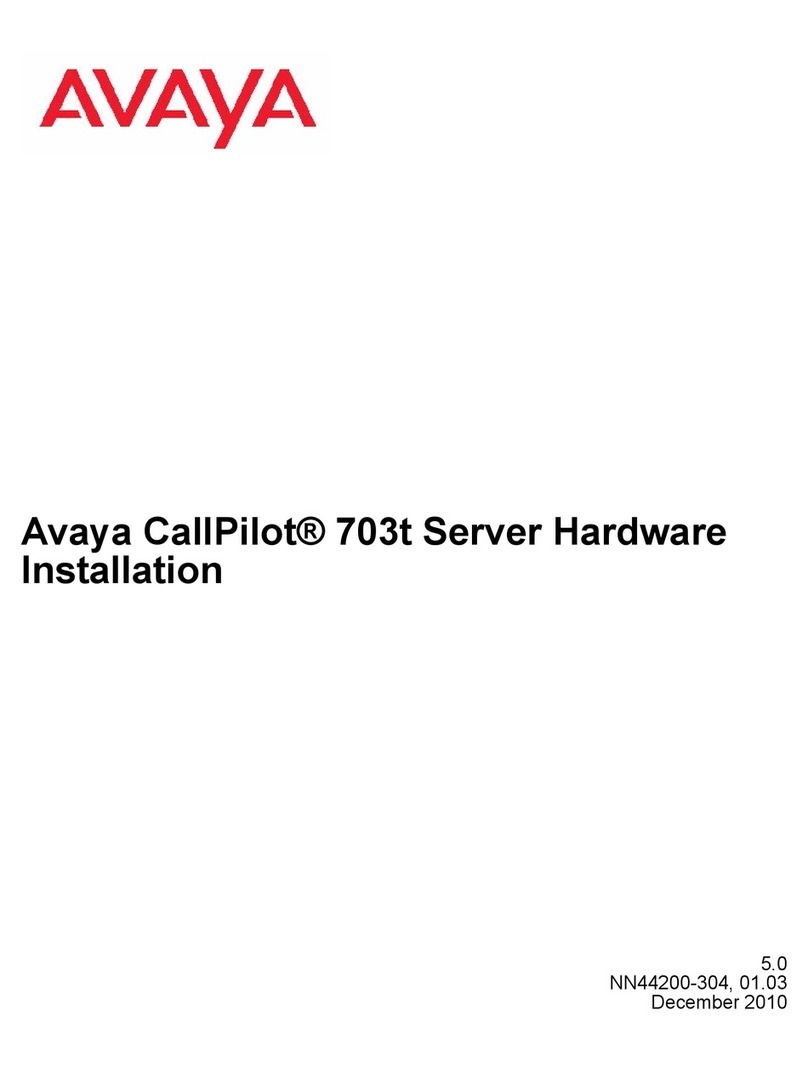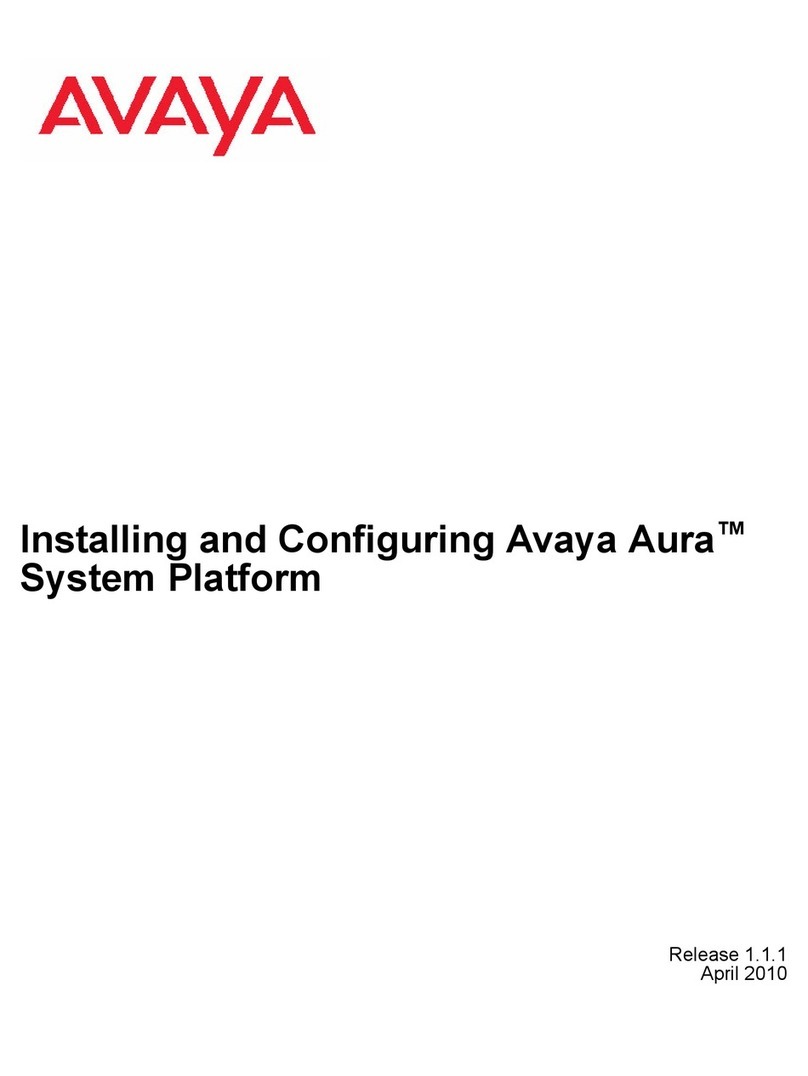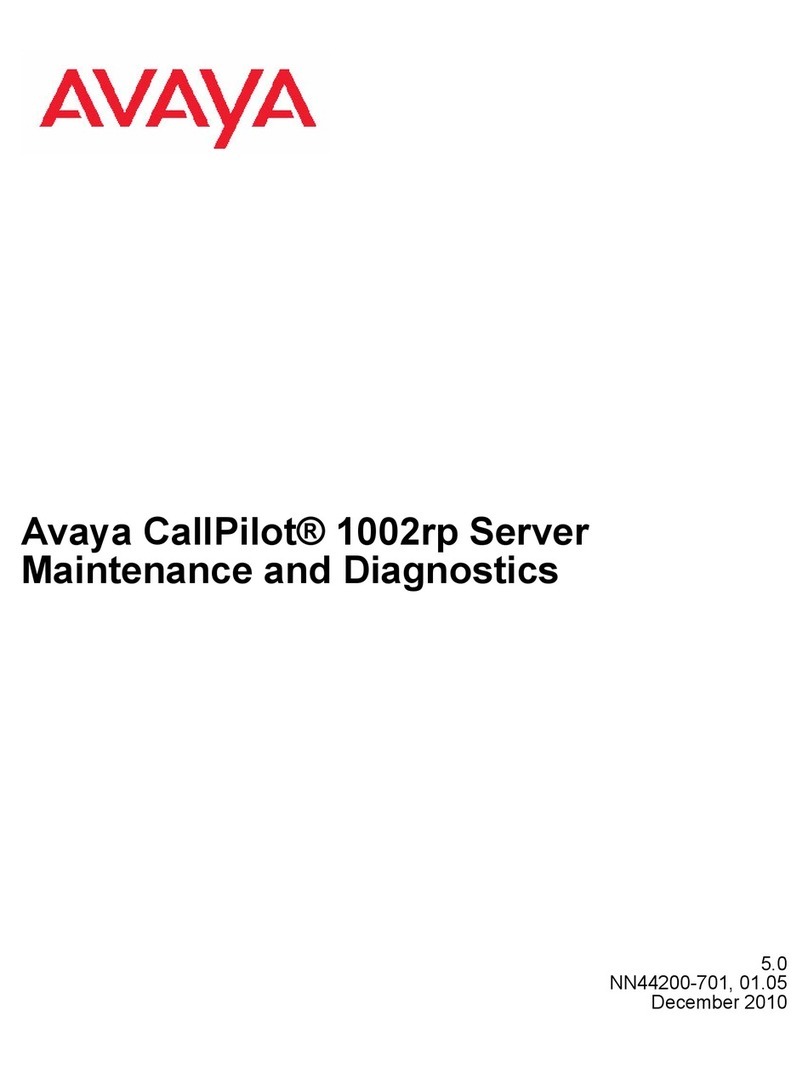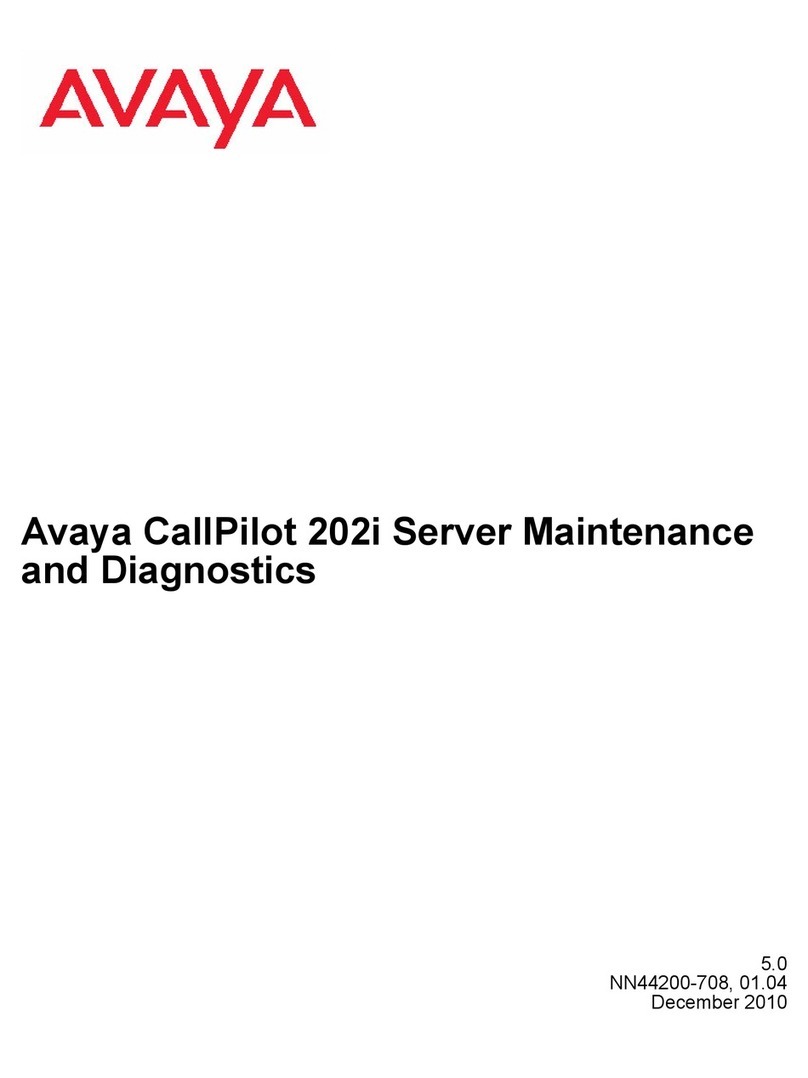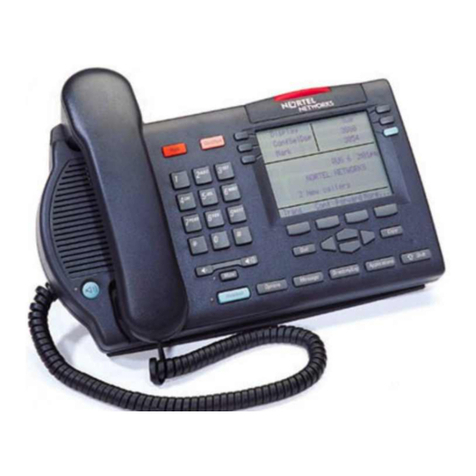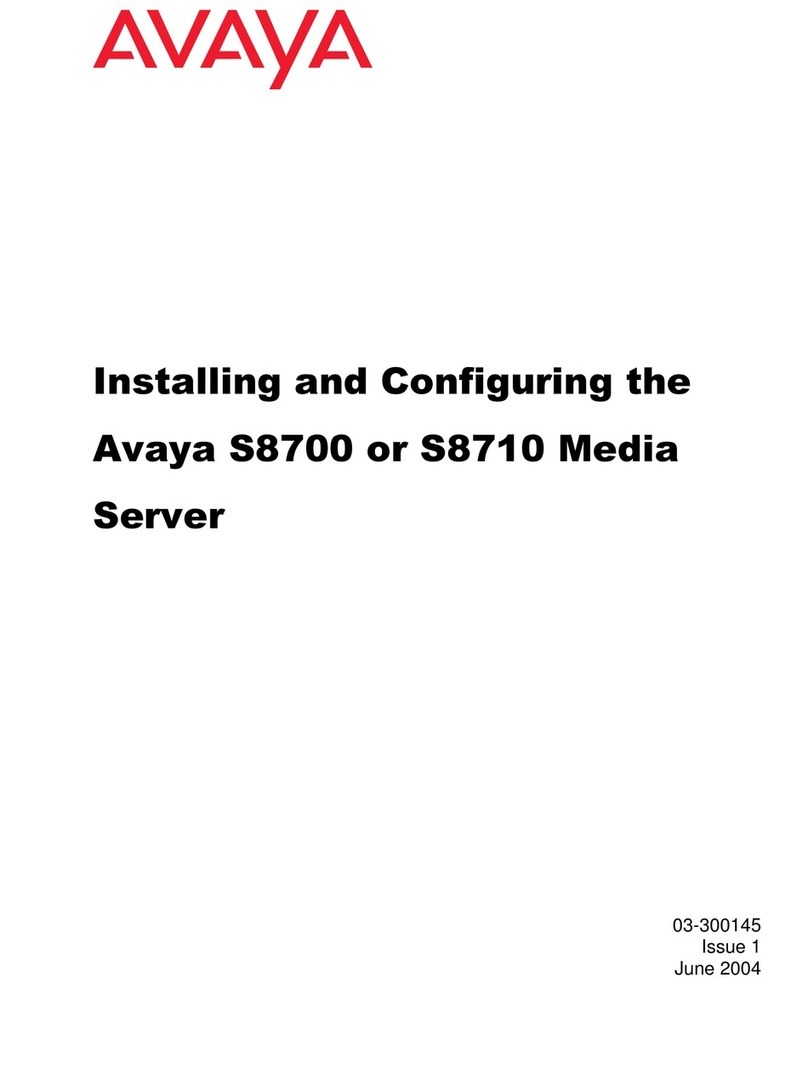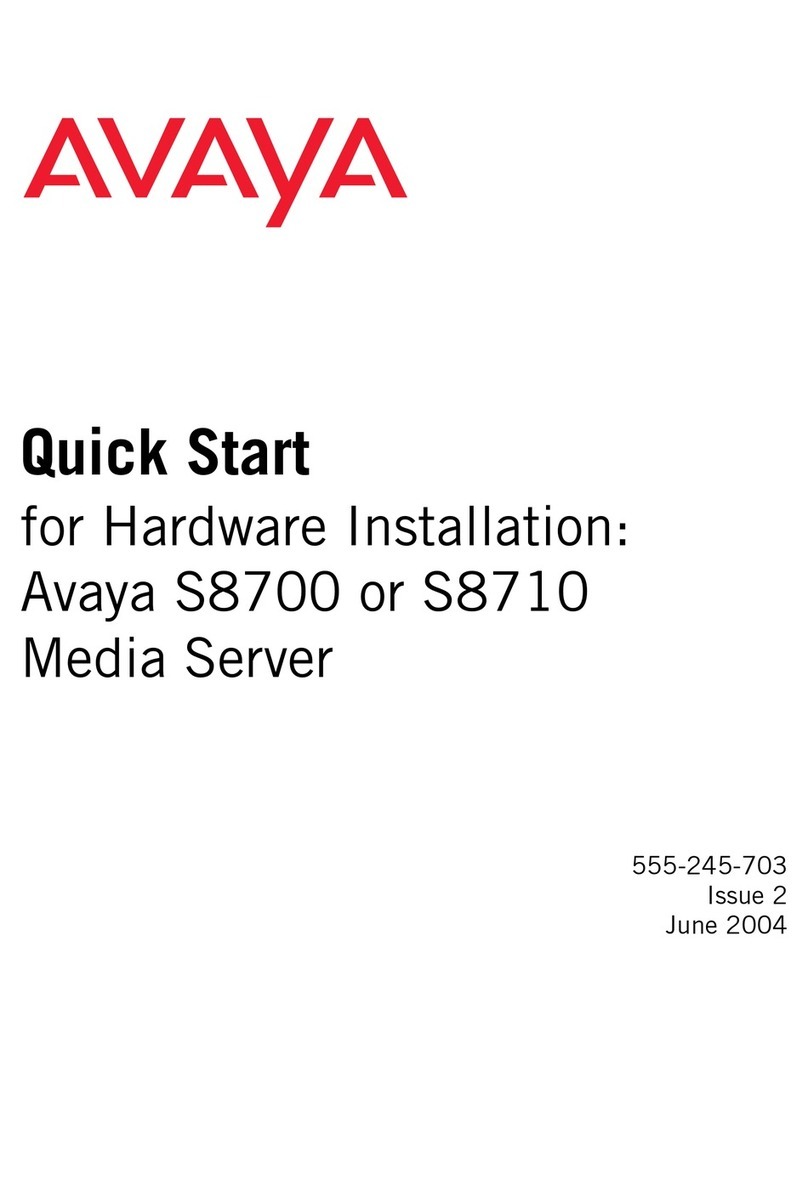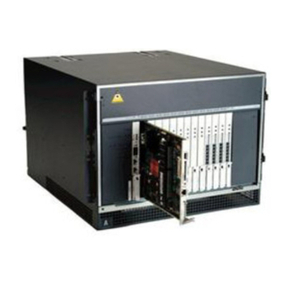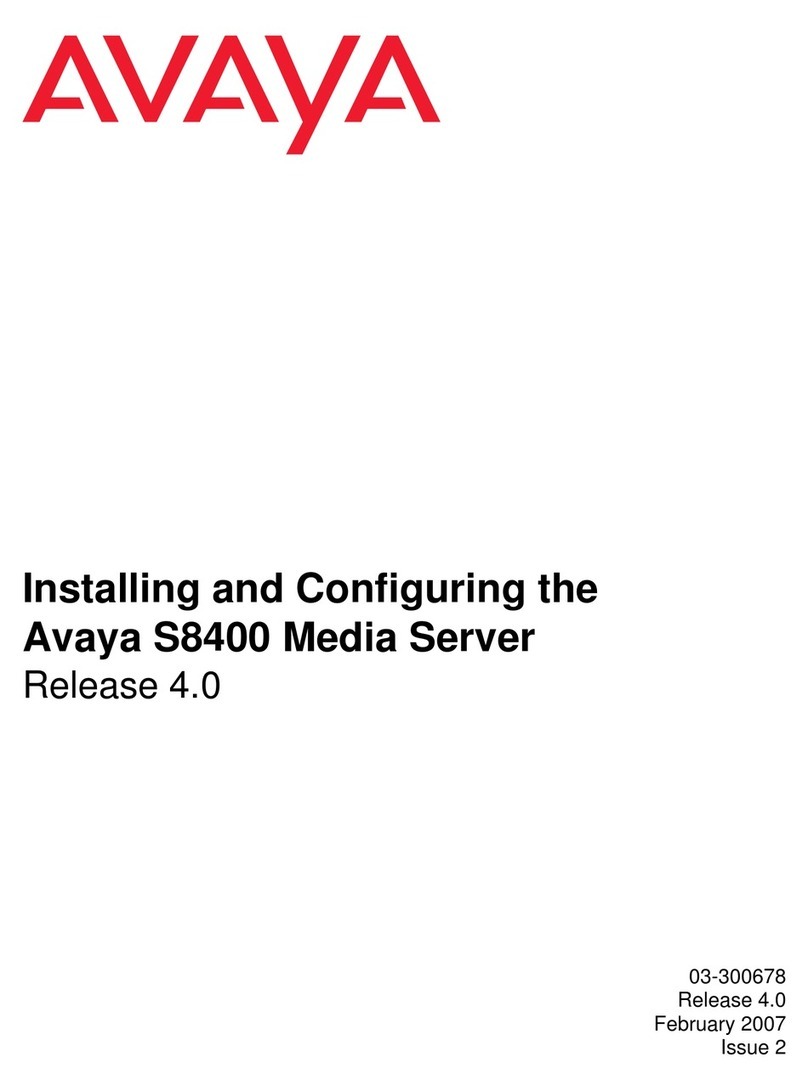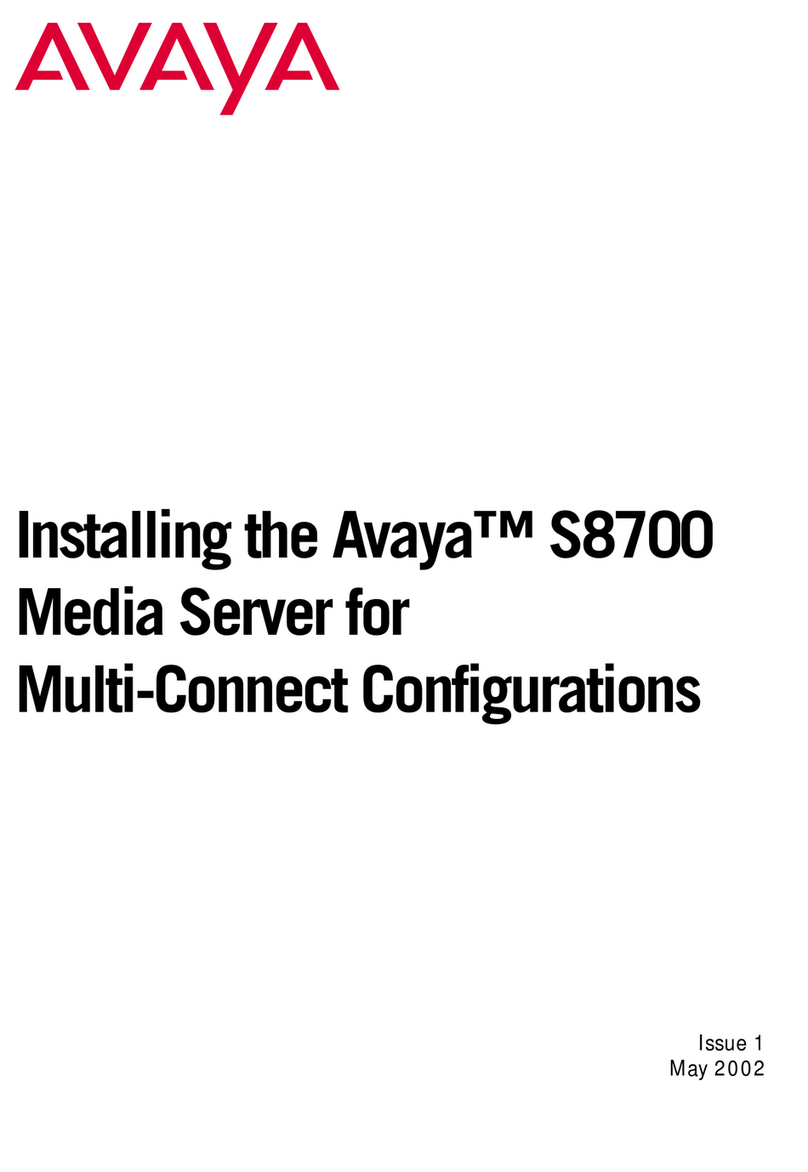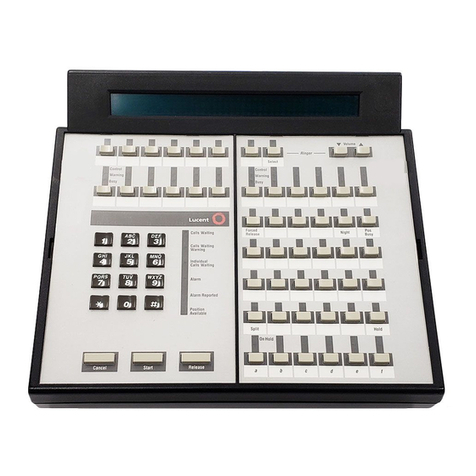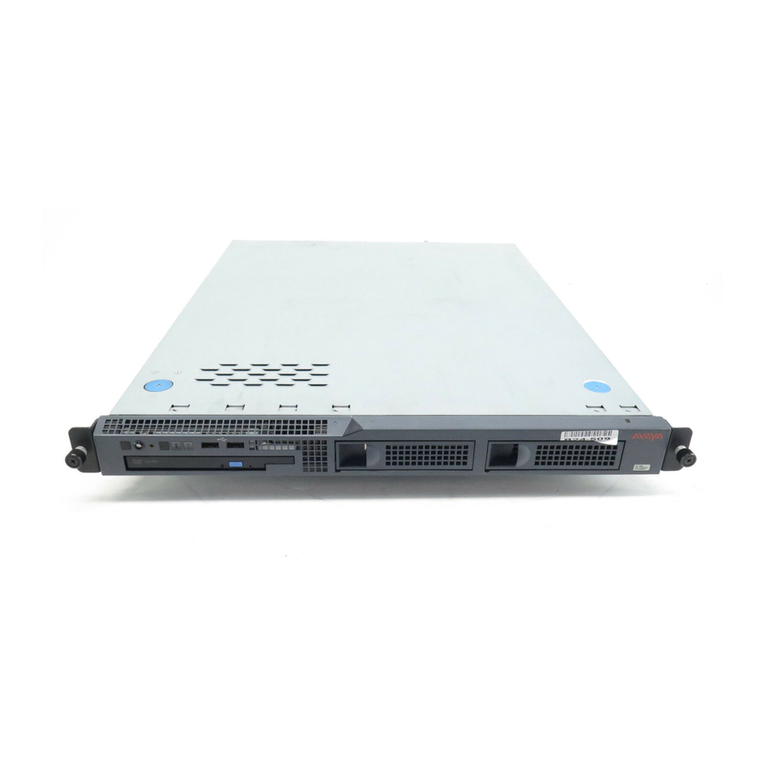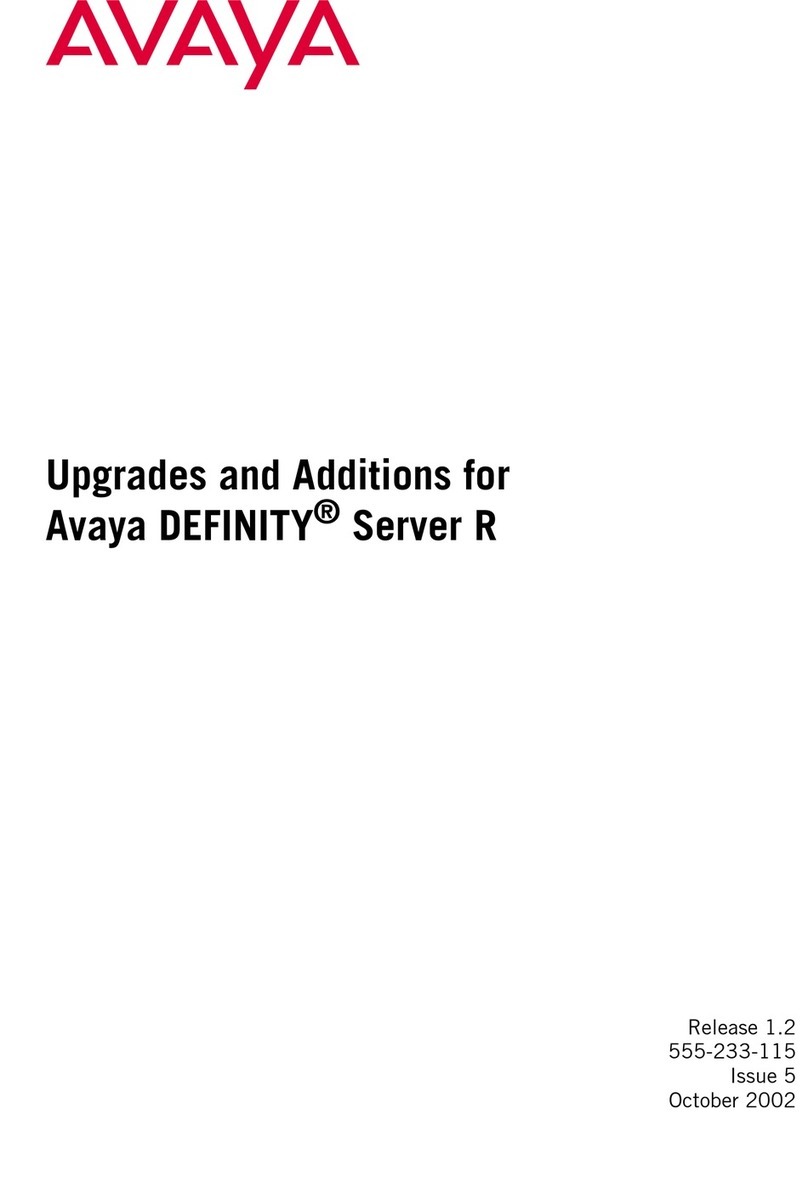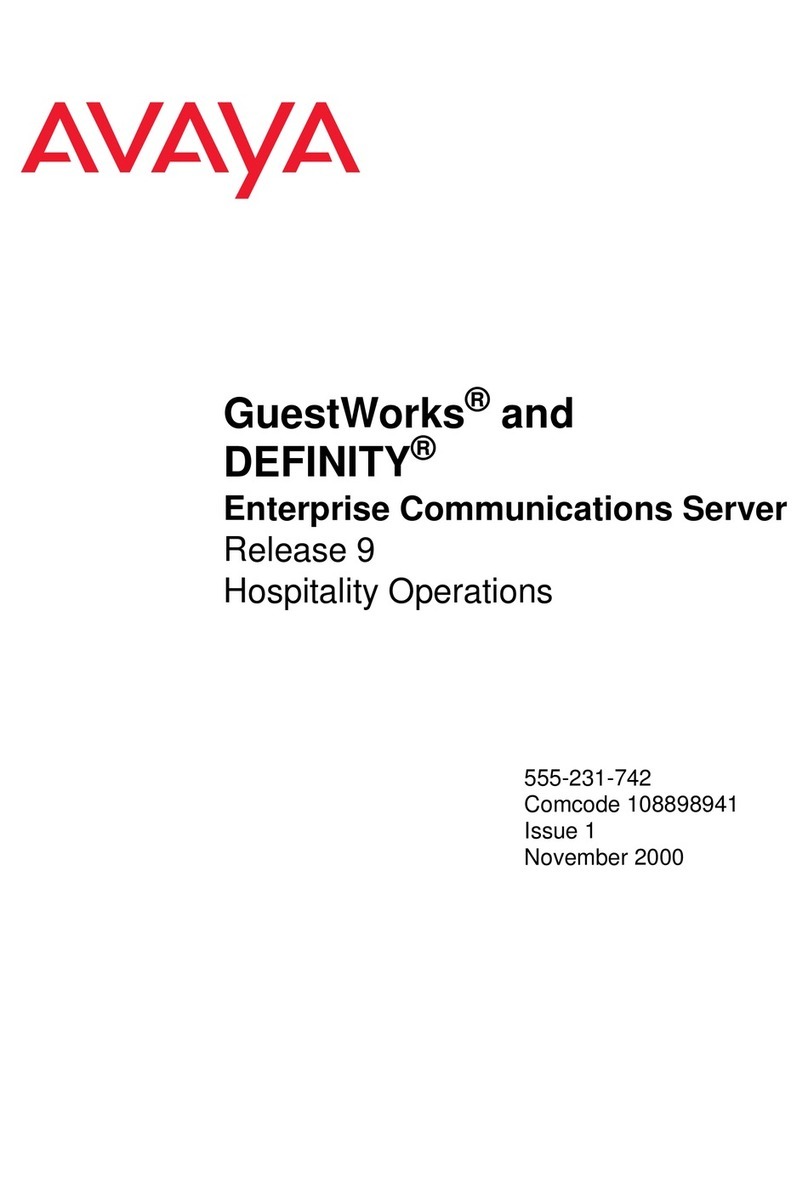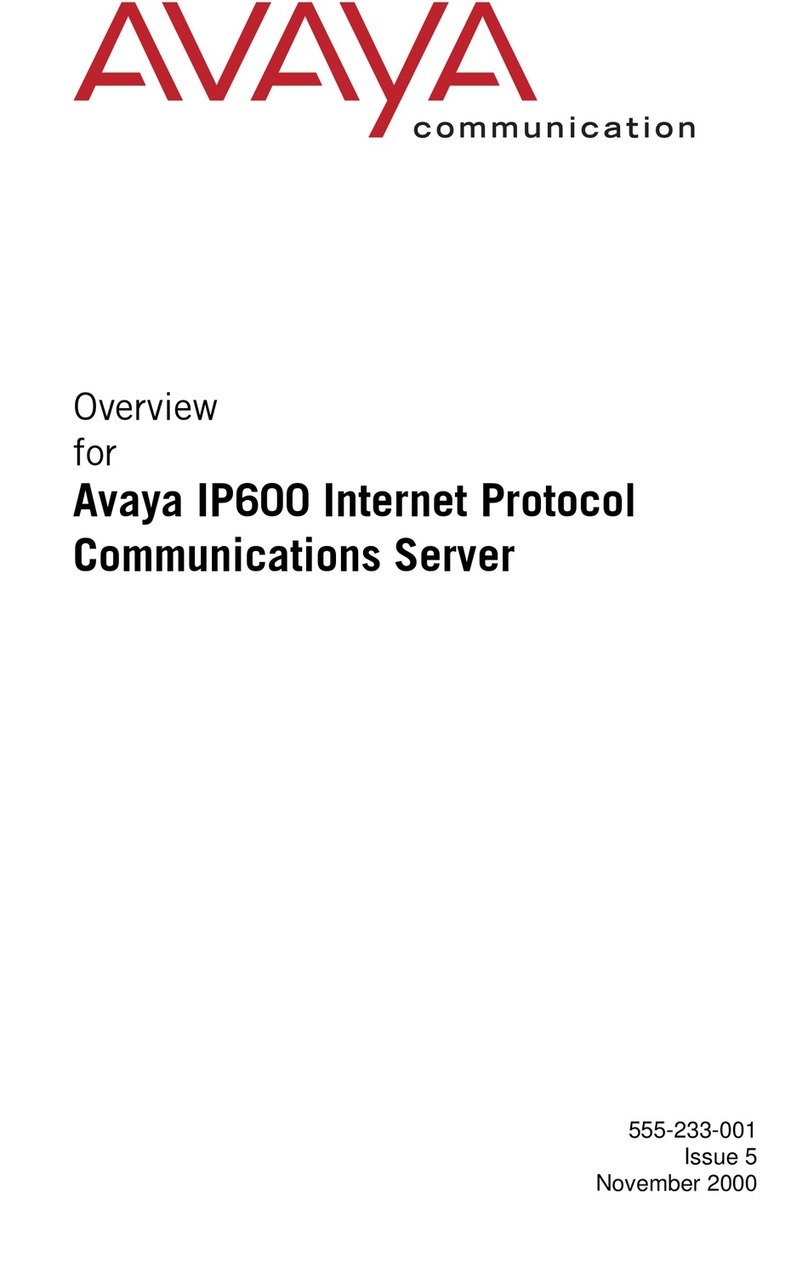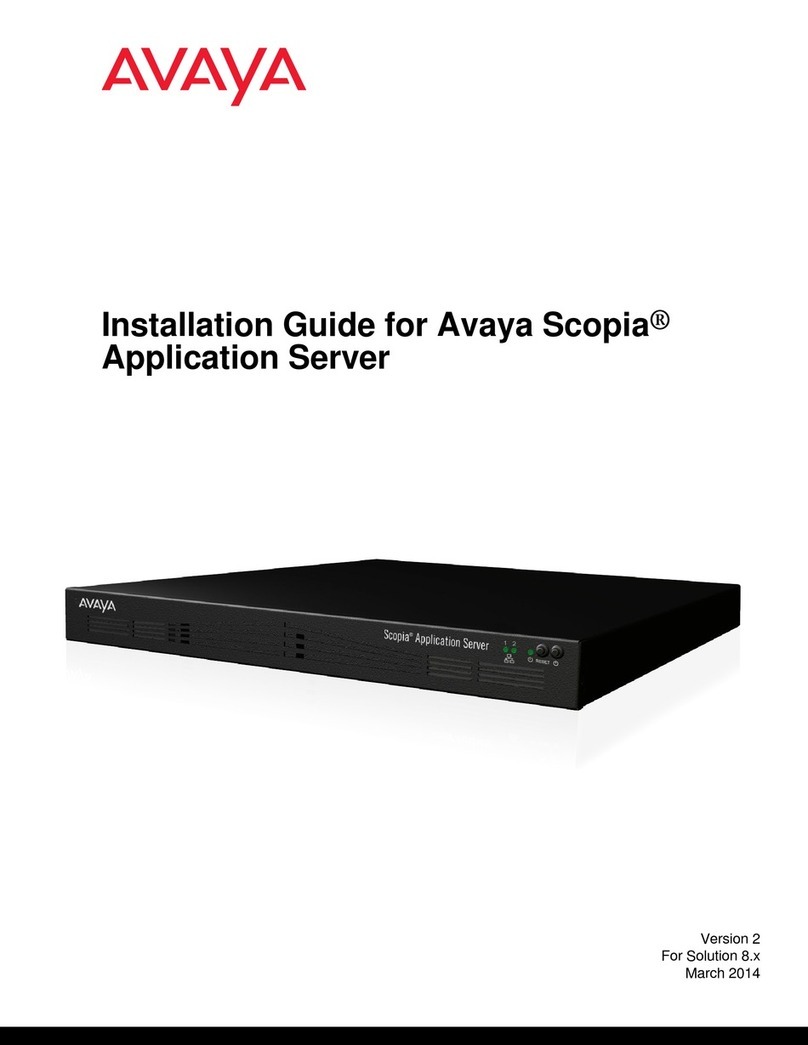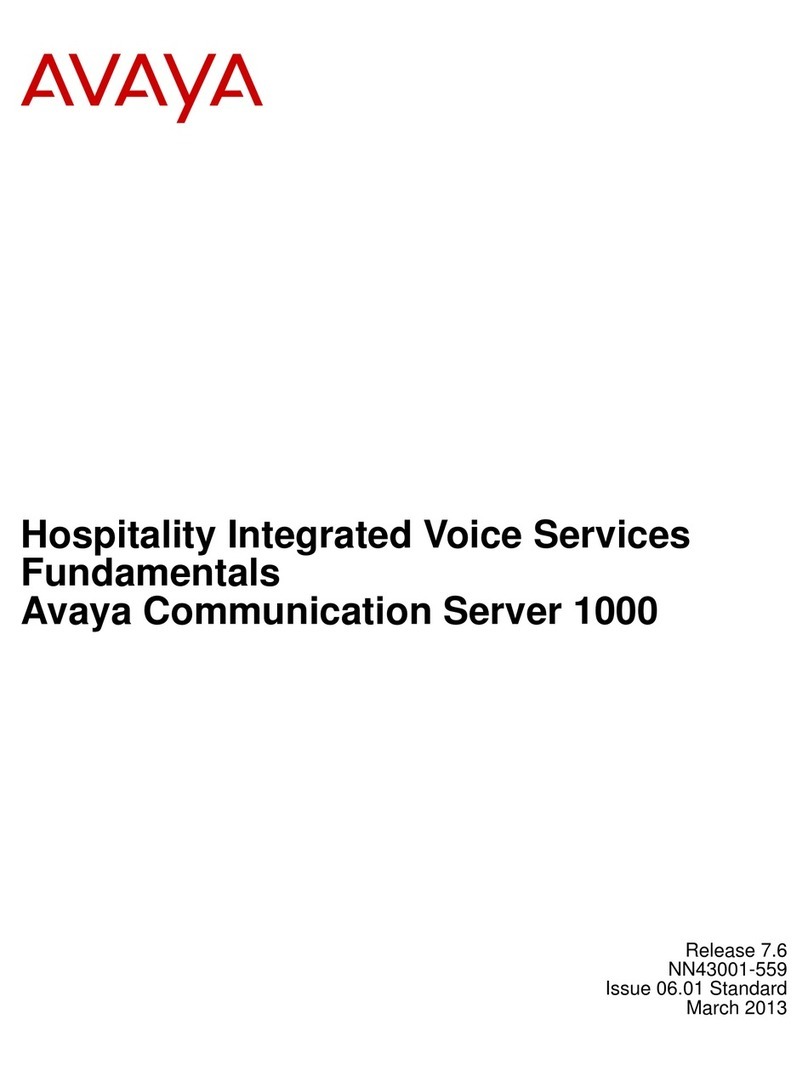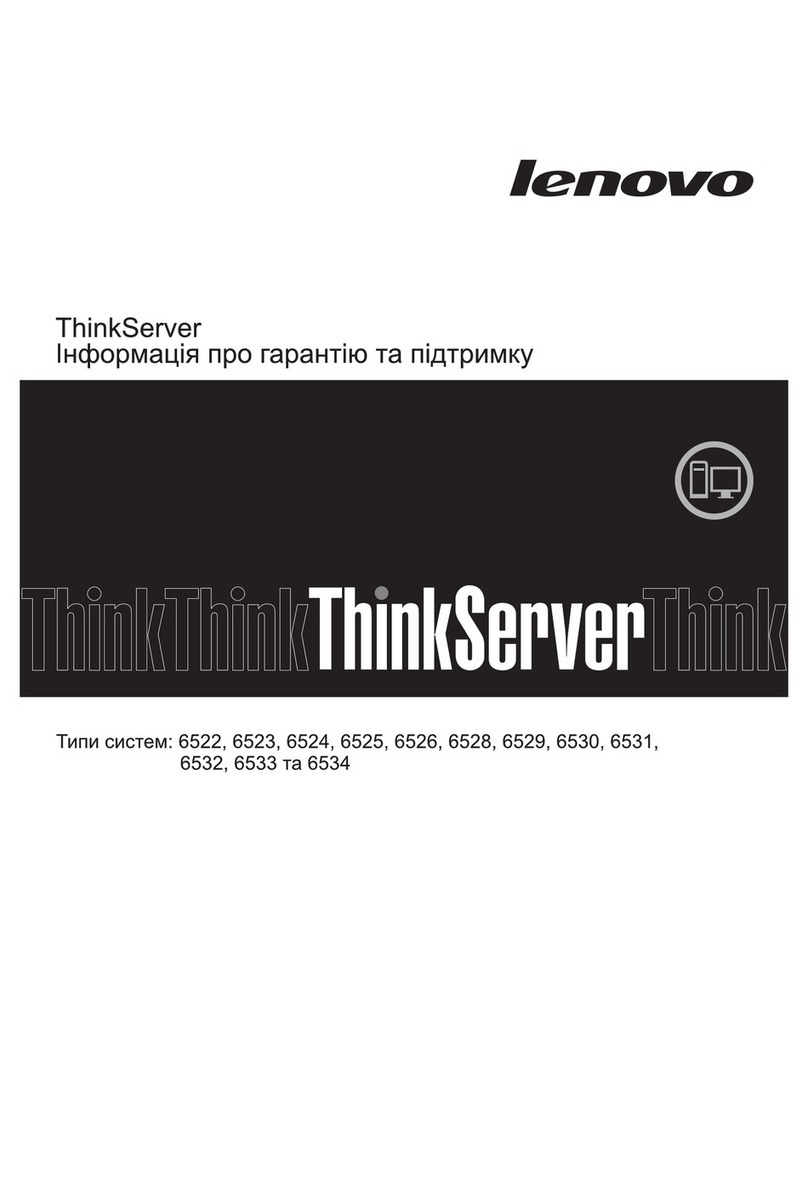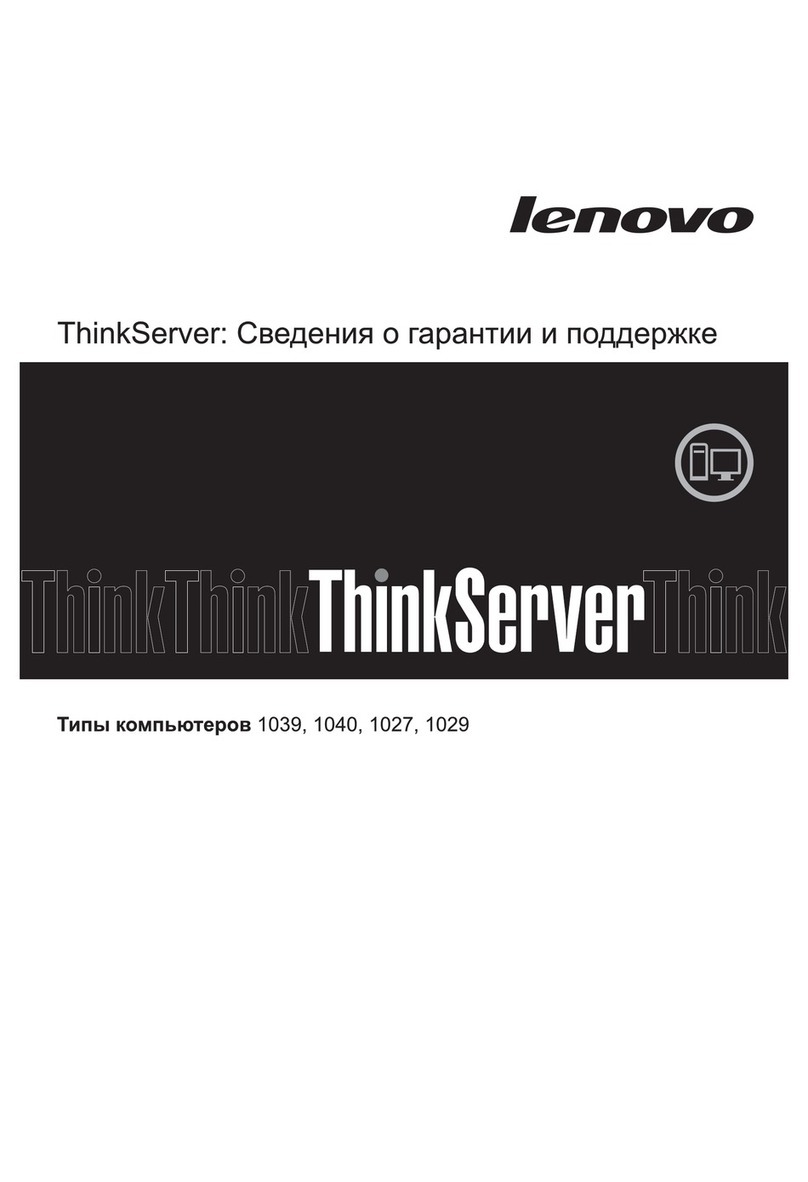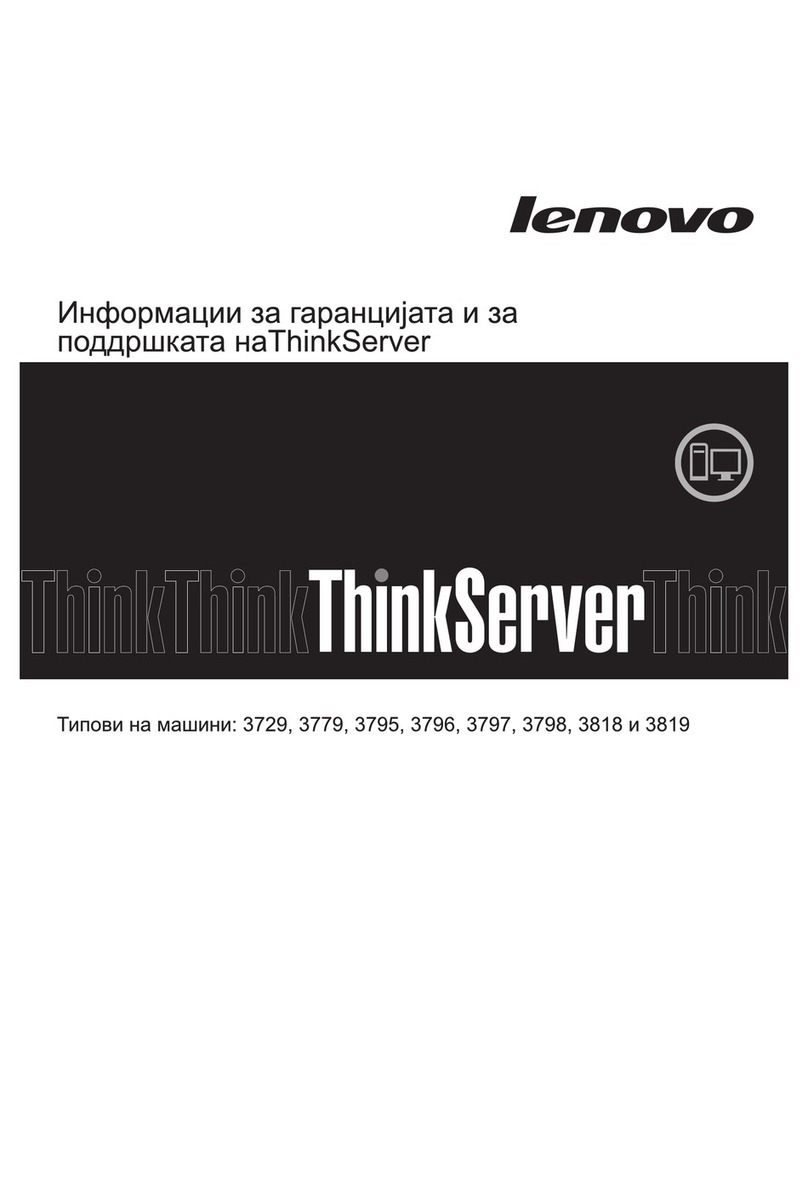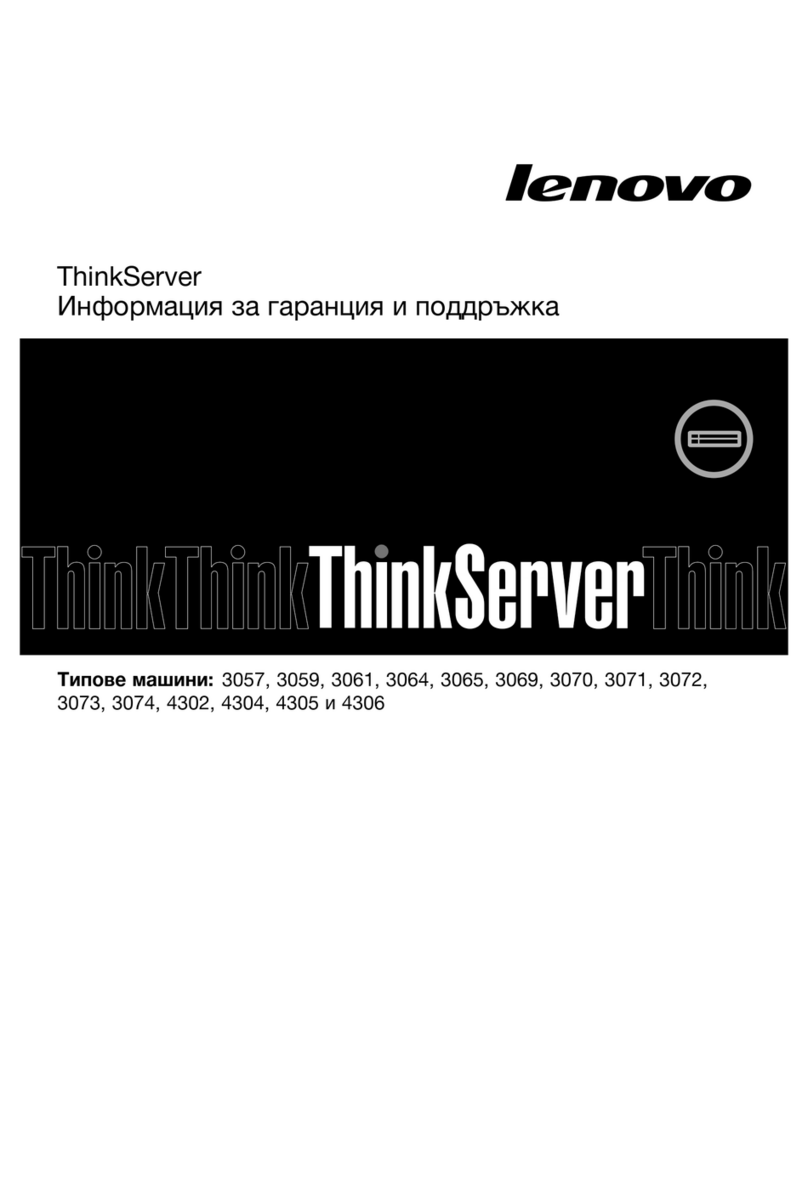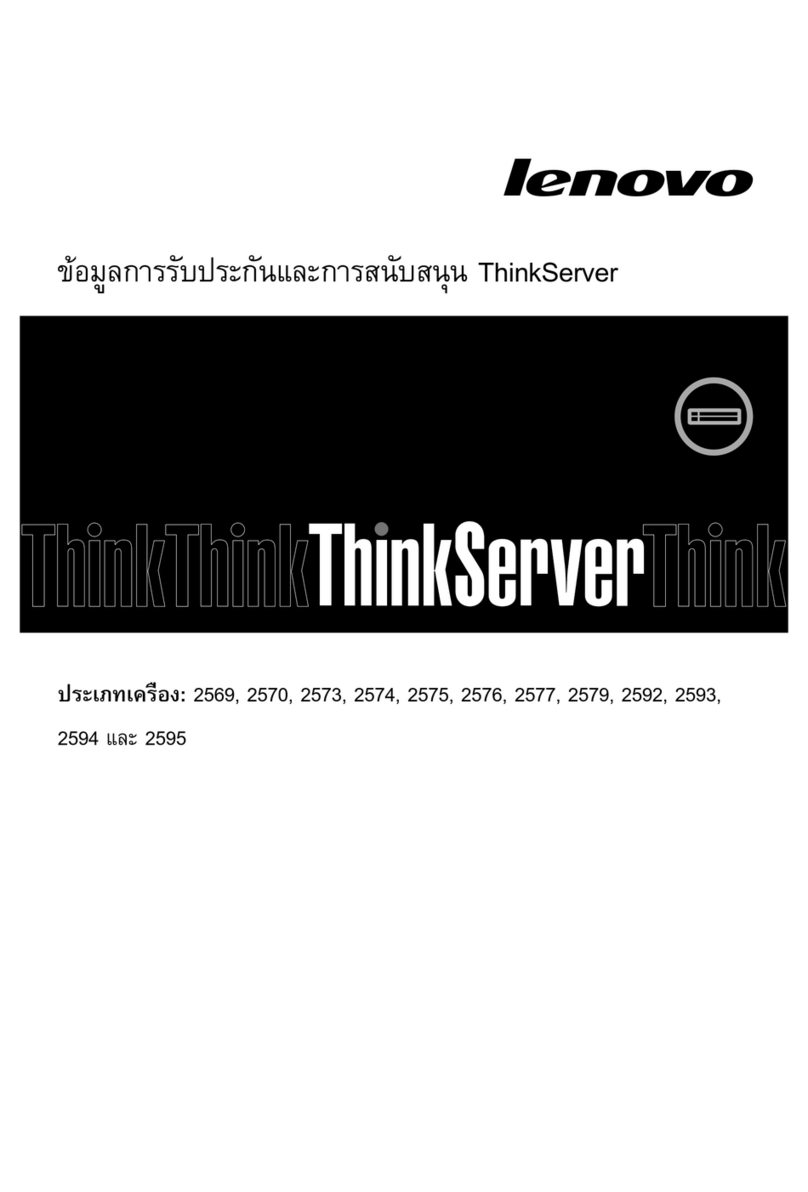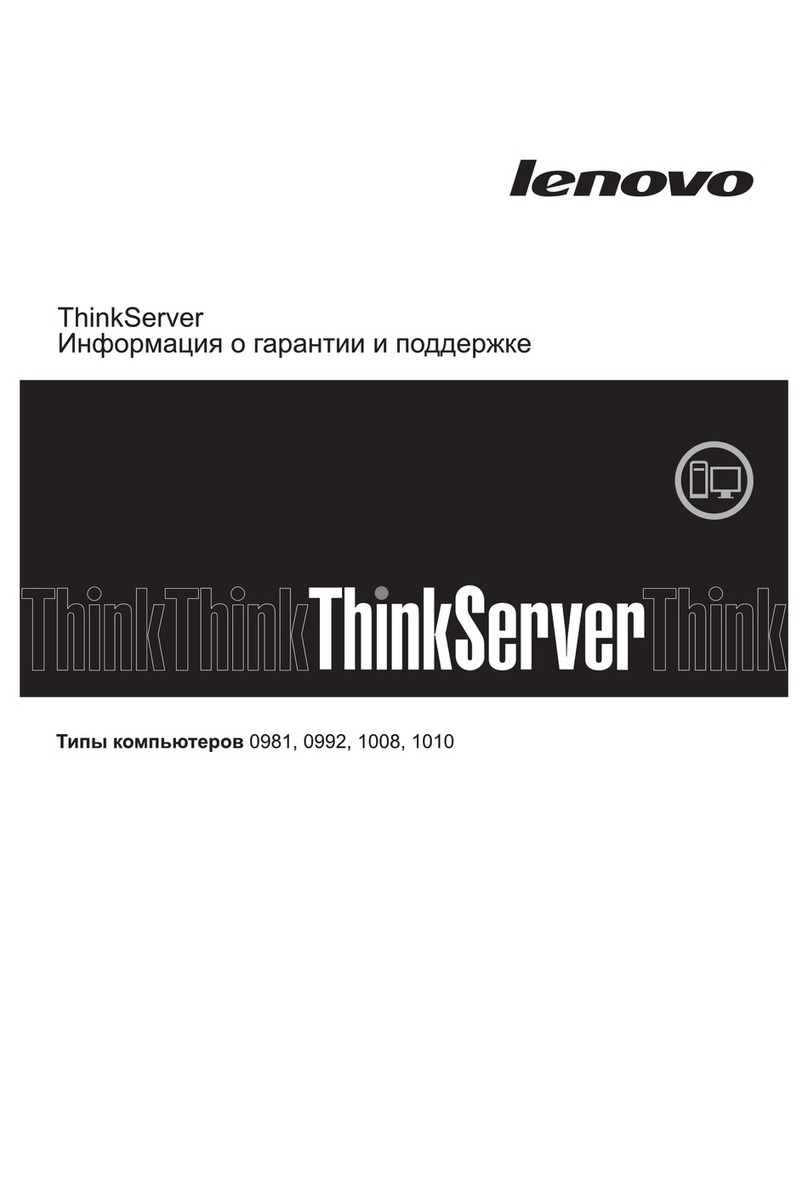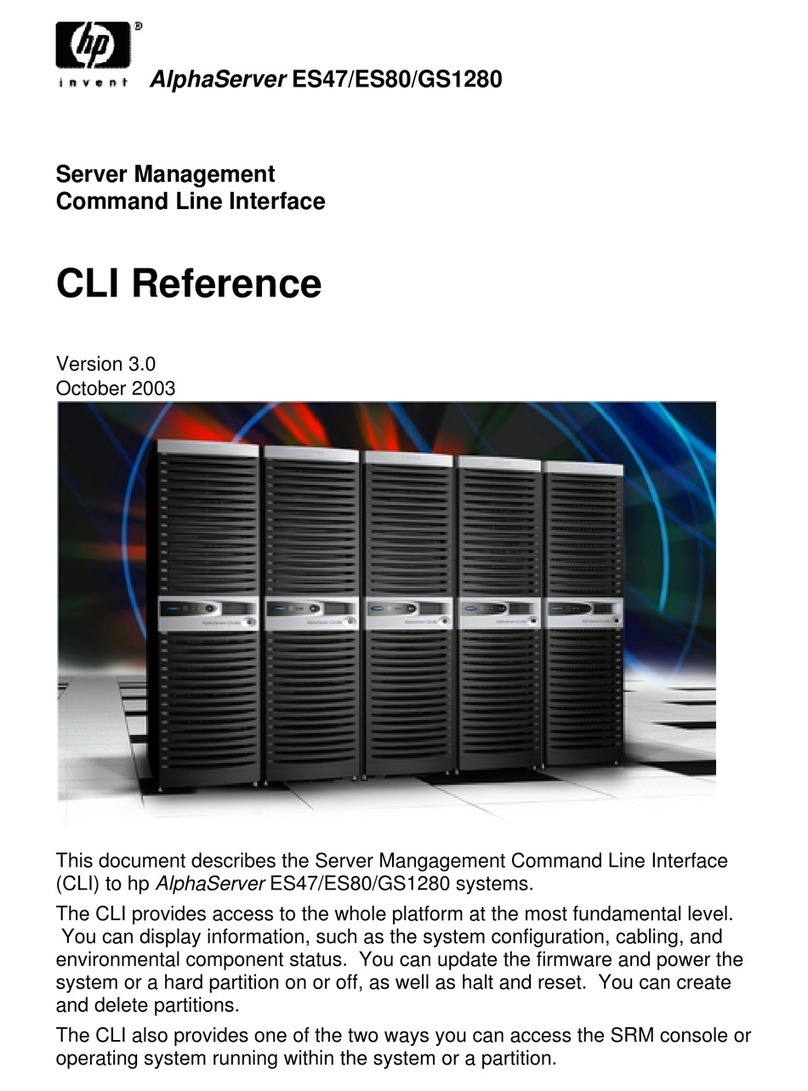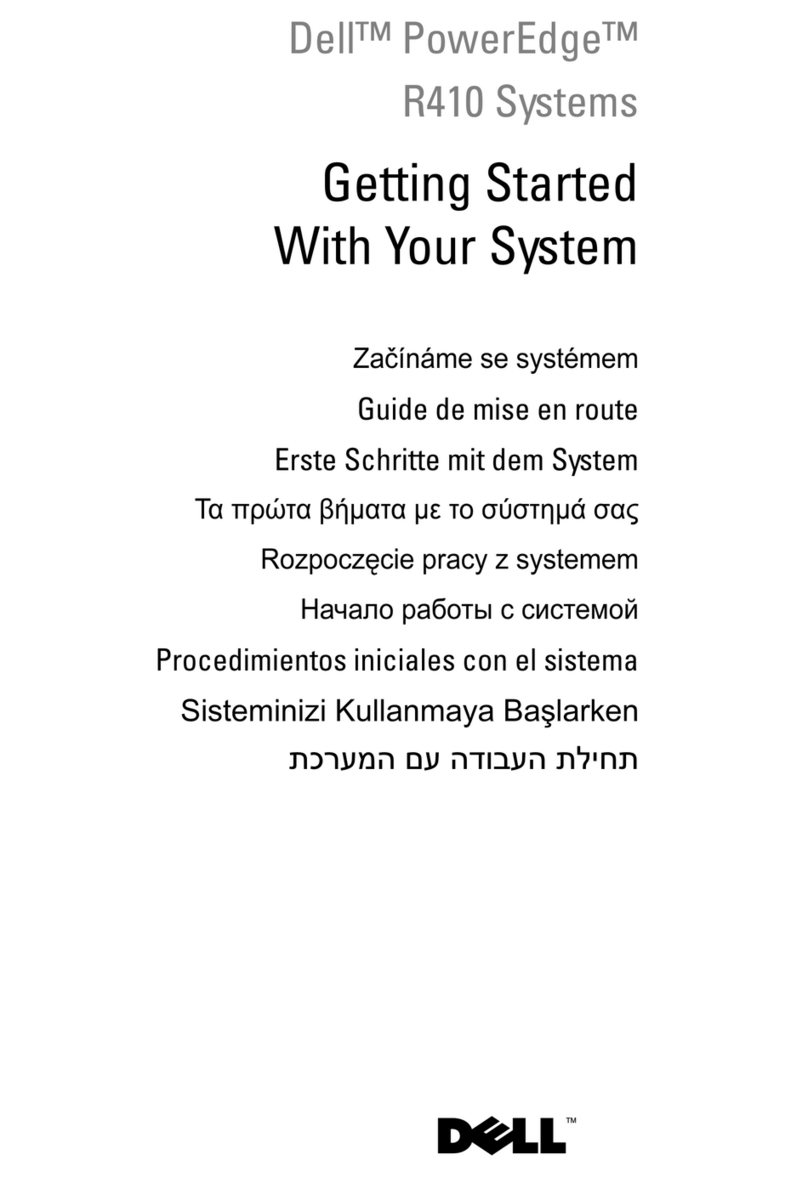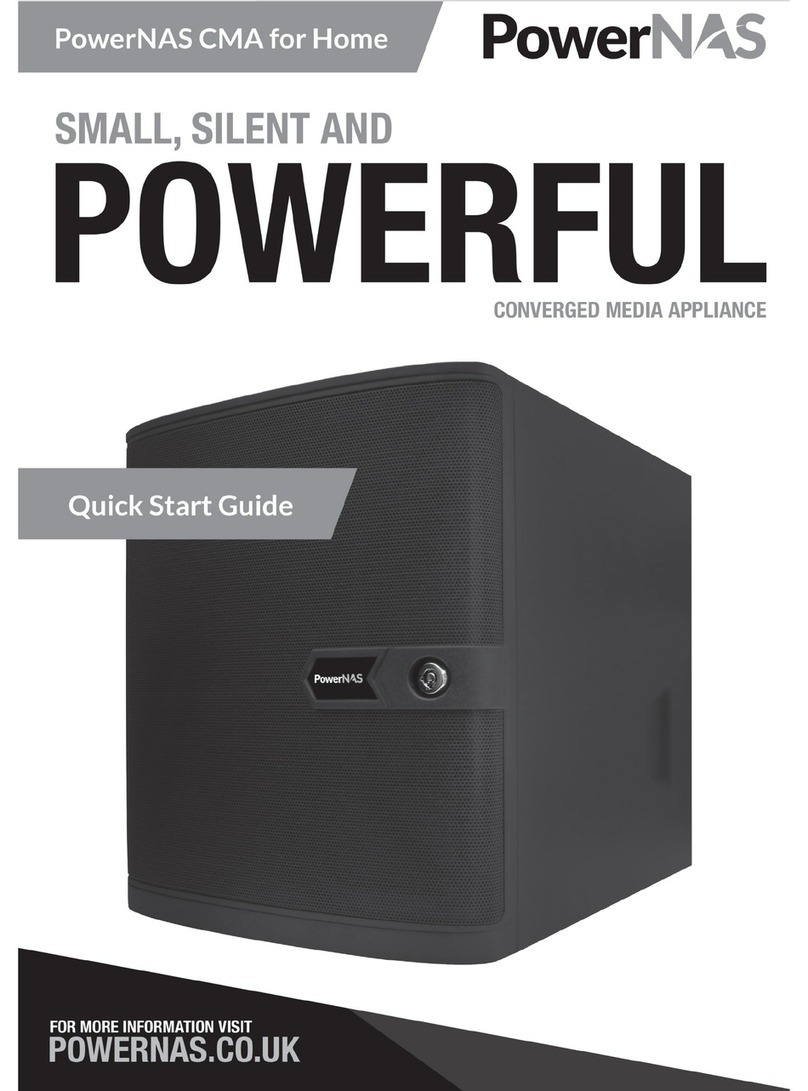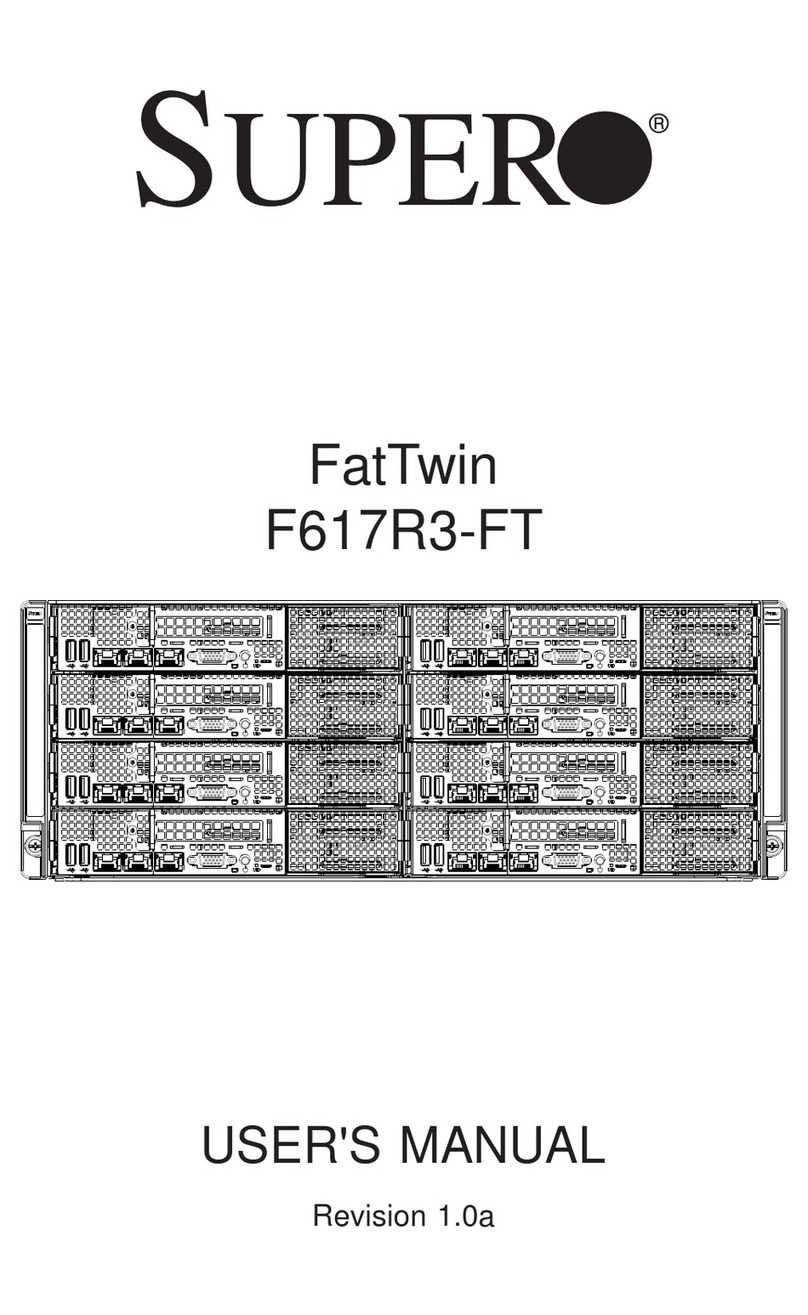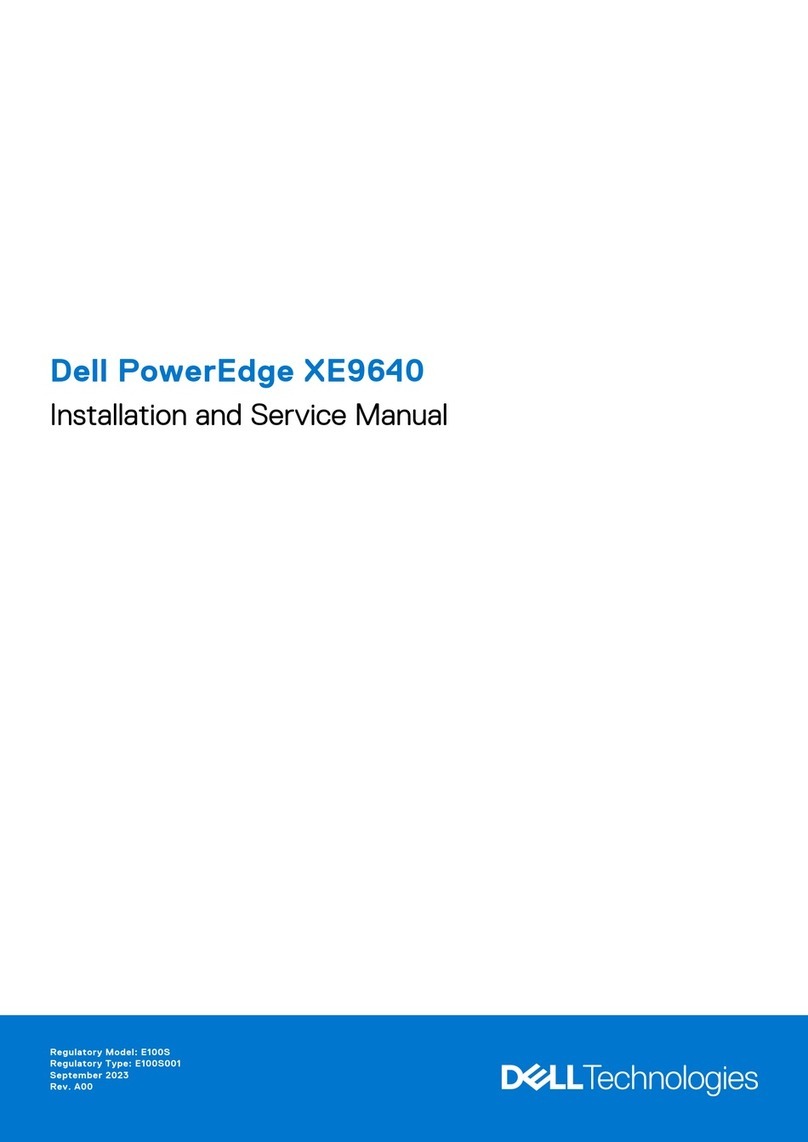
Copyright 2002, Avaya Inc.
All Rights Reserved
Notice
Every effort was made to ensure that the information in this document was
complete and accurate at the time of printing. However, information is sub-
ject to change.
Your Responsibility for Your Company’s
Telecommunications Security
The final responsibility for securing both this system and its networked
equipment rests with you - an Avaya customer's system administrator, your
telecommunications peers, and your managers. The scope of your respon-
sibilities is based upon acquired knowledge and resources from a variety of
sources including but not limited to:
• Installation documents
• System administration documents
• Security documents
• Hardware-/software-based security tools
• Shared information between you and your peers
• Telecommunications security experts
To prevent intrusions to your telecommunications equipment, you and your
peers should carefully program and configure:
• Your Avaya-provided telecommunications systems and their interfaces
• Your Avaya-provided software applications, and their underlying hard-
ware/software platforms and interfaces
• Any other equipment networked to your Avaya products.
Preventing Toll Fraud
“Toll fraud” is the unauthorized use of your telecommunications system by
an unauthorized party (for example, a person who is not a corporate em-
ployee, agent, subcontractor, or is not working on your company's behalf).
Be aware that there may be a risk of toll fraud associated with your system
and that, if toll fraud occurs, it can result in substantial additional charges for
your telecommunications services.
Avaya Fraud Intervention and how to get help
If you suspect that you are being victimized by toll fraud and you need tech-
nical assistance or support, in the United States and Canada, call the Tech-
nical Service Center's Toll Fraud Intervention Hotline at 1-800-643-2353.
For additional support telephone numbers, see the Avaya website:
http://www.avaya.com
Click on Support, click on Escalation Lists US and International. This web
site includes phone numbers for escalation within the United States. For es-
calation phone numbers outside the United States, click on Global Escala-
tion List. This list contains the phone numbers for the Centers of Excellence
in each Avaya-defined region.
Providing Telecommunications Security
Telecommunications security (of voice, data and/or video communications)
is the prevention of any type of intrusion to (that is, either unauthorized or
malicious access to or use of) your company’s telecommunications equip-
ment by some party.
Your company’s telecommunications equipment includes both this Avaya
product and any other voice/data/video equipment that could be accessed
via this Avaya product (that is, networked equipment).
An outside party is anyone who is not a corporate employee, agent, subcon-
tractor, or is not working on your company’s behalf. Whereas, a malicious
party is anyone (including someone who may be otherwise authorized) who
accesses your telecommunications equipment with either malicious or mis-
chievous intent.
Such intrusions may be either to/through synchronous (time-multiplexed
and. or circuit-based) or asynchronous (character-, message-, or packet-
based) equipment or interfaces for reasons of:
• Utilization (of capabilities special to the accessed equipment)
• Theft (such as, of intellectual property, financial assets, or toll-facility
access)
• Eavesdropping (privacy invasions to humans)
• Mischief (troubling, but apparently innocuous, tampering)
• Harm (such as harmful tampering, data loss or alteration, regardless
of motive or intent)
Be aware that there may be a risk of unauthorized intrusions associated with
your system and/or its networked equipment. Also realize than, if such an
intrusion should occur, it could result in a variety of losses to your company
(including but not limited to, human/data privacy, intellectual property, ma-
terial assets, financial resources, labor costs, and/or legal costs).
Voice over Internet Protocol (VoIP)
If the equipment supports Voice over Internet Protocol (VoIP) facilities, you
may experience certain compromises in performance, reliability and securi-
ty, even when the equipment performs as warranted. These compromises
may become more acute if you fail to follow Avaya’s recommendations for
configuration, operation and use of the equipment. YOU ACKNOWLEDGE
THAT YOU ARE AWARE OF THESE RISKS AND THAT YOU HAVE DE-
TERMINED THEY ARE ACCEPTABLE FOR YOUR APPLICATION OF
THE EQUIPMENT. YOU ALSO ACKNOWLEDGE THAT, UNLESS EX-
PRESSLY PROVIDED IN ANOTHER AGREEMENT, YOU ARE SOLELY
RESPONSIBLE FOR (1) ENSURING THAT YOUR NETWORKS AND
SYSTEMS ARE ADEQUATELY SECURED AGAINST UNAUTHORIZED
INTRUSION AND (2) BACKING UP YOUR DATA AND FILES.
Standards Compliance
Avaya Inc. is not responsible for any radio or television interference caused
by unauthorized modifications of this equipment or the substitution or at-
tachment of connecting cables and equipment other than those specified by
Avaya Inc. The correction of interference caused by such unauthorized
modifications, substitution or attachment will be the responsibility of the us-
er. Pursuant to Part 15 of the FCC Rules, the user is cautioned that changes
or modifications not expressly approved by Avaya Inc. could void the user’s
authority to operate this equipment.
The equipment described in this manual complies with standards of the fol-
lowing organizations and laws, as applicable:
• Australian Communications Agency (ACA)
• American National Standards Institute (ANSI)
• Canadian Standards Association (CSA)
• Committee for European Electrotechnical Standardization
(EENELEC) - European Norms (EN’s)
• Digital Private Network Signaling System (DPNSS)
• European computer Manufactures Association (ECMA)
• European Telecommunications Standards Institute (ETSI)
• FCC Rules Parts 15 and 68
• International Electrotechnical Commission (IEC)
• International Special Committee on Radio Interference (CISPR)
• International Telecommunications Union Telephony (ITU-T)
• ISDN PBX Network Specification (IPNS)
• National ISDN-1
• National ISDN-2
• Underwriters Laboratories (UL)
Electromagnetic Compatibility (EMC) Standards
This product complies with and conforms to the following international IMC
standards and all relevant national deviations:
Limits and Methods of Measurement of Radio Interference of Information
Technology Equipment, CISPR 22:1997 and EN55022:1998.
Information Technology Equipment - Immunity Characteristics - Limits and
Methods of Measurement, CISPR 24:1997 and EN55024:1998, including:
• Electrostatic Discharge (ESD) IEC 61000-4-2
• Radiated Immunity IEC 61000-4-3
• Electrical Fast Transient IEC 61000-4-4
• Lightning Effects IEC 61000-4-5
• Conducted Immunity IEC 61000-4-6
• Mains Frequency Magnetic Field IEC 61000-4-8
• Voltage Dips and Variations IEC 61000-4-11
• Powerline Harmonics IEC 61000-3-2
• Voltage Fluctuations and Flicker IEC 61000-3-3
Ordering Information
Call: US Voice: 1 800 457 1235
US Fax: 1 800 457 1764
non-US Voice: +1 410 568 3680
non-US Fax: +1 410 891 0207
Write: Globalware Solutions
200 Ward Hill Avenue
Haverhill, MA 01835 USA
Order: 555-234-200, Issue 1
May, 2002
Canadian Department of Communications (DOC)
This Class B digital apparatus complies with Canadian ICES-003.
Cet appareil numérique de la classe A est conforme à la norme NMB-003
du Canada.
